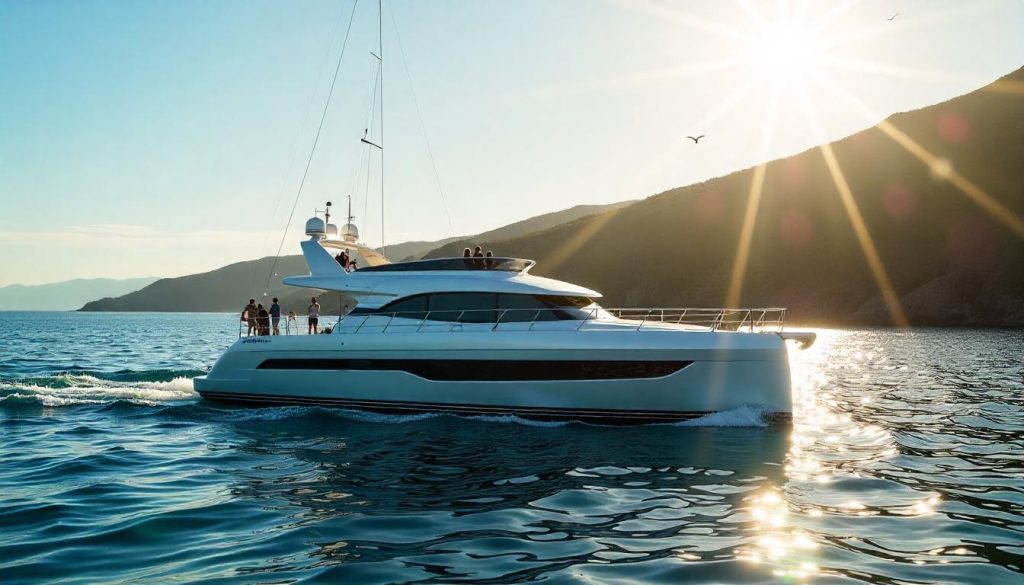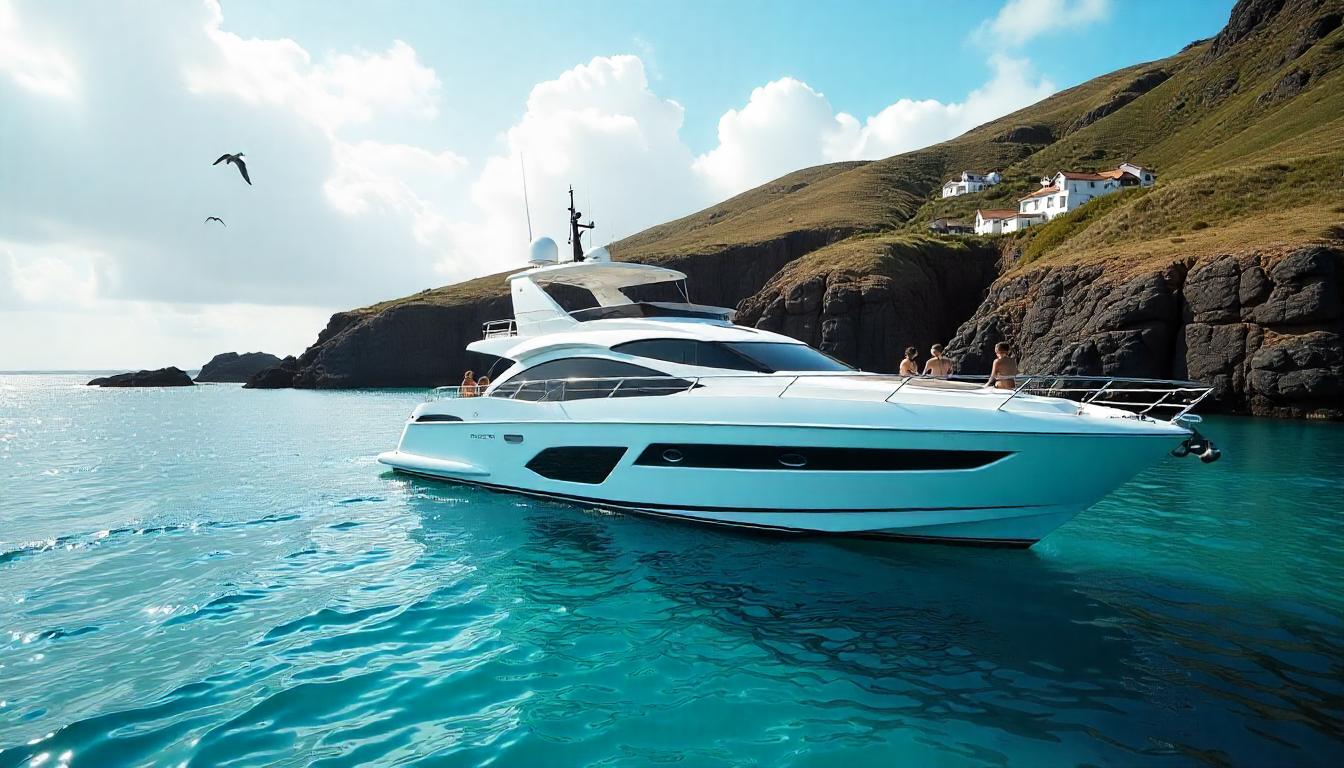The Azores, a remote archipelago in the mid-Atlantic, offer a serene escape for sailors seeking natural beauty and adventure, making Azores mid-Atlantic yachting in 2025 a hidden gem for yachters. With nine volcanic islands, average winter temperatures of 18°C, and waters teeming with marine life, per meteorological data, the Azores provide a unique sailing experience. From São Miguel’s lush landscapes to Faial’s vibrant marina, this guide explores the best islands, highlights natural wonders, and shares practical tips for a seamless yachting journey. Let’s set sail through the Azores’ emerald waters.
São Miguel: The Green Island Gateway
São Miguel, the largest island in the Azores, serves as a gateway for yachters exploring this mid-Atlantic paradise. Begin at Ponta Delgada Marina, which accommodates yachts up to 60 meters. For example, the marina has depths of 5-8 meters, per port data. Also, mooring fees average $55 per night for a 40-meter yacht, per tariffs. You can stock up on supplies at local markets, where fresh pineapples cost $2 per kilo, per vendors. The waters average 18°C in spring, per reports. Thus, São Miguel is an ideal starting point for your Azores mid-Atlantic yachting adventure.
Sete Cidades: A Volcanic Crater Lake
Sete Cidades, a volcanic crater on São Miguel’s western side, offers a stunning natural wonder for yachters. A 30-minute taxi ride from Ponta Delgada, costing $25, leads to this breathtaking site, per guides. For instance, the crater spans 4.5 kilometers, with twin lakes—one blue, one green—nestled within, per geological data. Also, you can hike to the Vista do Rei viewpoint, offering panoramic views, per locals. The area’s lush forests are home to Azorean bullfinches, per wildlife reports. Moreover, the serene lakes make it ideal for photography, per visitors. This natural spectacle makes Sete Cidades a highlight. Therefore, it’s a must-visit on São Miguel.
Furnas: A Geothermal Retreat
Furnas, on São Miguel’s eastern side, provides a geothermal retreat for yachters. For example, a 45-minute taxi ride from Ponta Delgada, costing $35, leads to this volcanic valley, per guides. Also, the area features hot springs, with entry fees of $5 per person, per park rules. You can taste “cozido,” a stew cooked underground by geothermal heat, for $15, per local restaurants. The Furnas Lake, surrounded by steaming geysers, adds a mystical vibe, per visitors. Additionally, the Terra Nostra Garden, with its thermal pool, costs $8 to enter, per operators. This unique spot makes Furnas a standout. Thus, it’s a top stop for sailors in São Miguel.
Faial: The Sailor’s Hub for Azores Mid-Atlantic Yachting
Faial, known as the “Blue Island” for its hydrangeas, offers a sailor’s hub for Azores mid-Atlantic yachting in 2025. Anchor at Horta Marina, a legendary stop for transatlantic sailors, which accommodates yachts up to 50 meters. For instance, the marina has depths of 4-6 meters, per port data. Also, mooring fees average $50 per night for a 40-meter yacht, per tariffs. The waters average 18°C, per reports. You can enjoy a gin and tonic at Peter Café Sport for $7, a sailor’s tradition, per menus. The 130-nautical-mile sail from São Miguel is a scenic journey, per marine charts. Thus, Faial is a key destination for yachters.
Capelinhos Volcano: A Lunar Landscape
Capelinhos Volcano, on Faial’s western tip, provides a lunar landscape for yachters. A 20-minute taxi ride from Horta, costing $20, leads to this volcanic site, per guides. For example, the 1957 eruption added new land to the island, now a barren expanse, per geological data. Also, the Capelinhos Interpretation Center, costing $5 to enter, offers exhibits on the eruption, per operators. You can walk along the ash-covered cliffs, spotting whales offshore, per locals. Moreover, the stark terrain contrasts with Faial’s greenery, per visitors. This dramatic spot makes Capelinhos a highlight. Therefore, it’s a must-visit on Faial.
Horta’s Painted Marina: A Sailor’s Tradition
Horta’s Painted Marina, within Horta Marina, offers a sailor’s tradition for yachters. For instance, sailors paint murals on the marina walls to mark their visit, a custom dating back decades, per historical records. Also, the marina’s waters average 18°C, with visibility up to 30 meters, per reports. You can hire a local artist to create your mural for $50, per operators. The colorful paintings add a festive vibe to the marina, per visitors. Additionally, the tradition fosters a sense of camaraderie among sailors, per locals. This unique spot makes Horta’s Painted Marina a standout. Thus, it’s a top stop for sailors in Faial.
Pico: A Wine and Whale-Watching Haven
Pico, dominated by Mount Pico, offers a wine and whale-watching haven for Azores mid-Atlantic yachting in 2025. Anchor at Madalena Marina, which accommodates yachts up to 40 meters. For example, the marina has depths of 4-6 meters, per port data. Also, mooring fees average $45 per night for a 40-meter yacht, per tariffs. The waters average 18°C, per reports. You can taste Pico’s volcanic wines, costing $10 per bottle, at local wineries, per vendors. The 5-nautical-mile sail from Faial is a short hop, per marine charts. Thus, Pico is a delightful stop for yachters.
Mount Pico: A Challenging Ascent
Mount Pico, Portugal’s highest peak at 2,351 meters, provides a challenging ascent for yachters. For instance, a 15-minute taxi ride from Madalena, costing $15, leads to the trailhead, per guides. Also, the climb takes 7 hours round-trip, requiring a guide for $50, per operators. You can see panoramic views of Faial and São Jorge on clear days, per locals. The trail passes through volcanic terrain, per geological data. Moreover, the summit’s crater offers a glimpse of Pico’s volcanic history, per visitors. This adventurous spot makes Mount Pico a highlight. Therefore, it’s a top activity on Pico.
Lajido de Santa Luzia: A Volcanic Vineyard
Lajido de Santa Luzia, near Madalena, offers a volcanic vineyard for yachters. For example, the area’s basalt walls protect vines from the wind, a UNESCO-recognized practice, per cultural data. Also, you can join a wine tasting for $15, sampling Verdelho wines, per wineries. The vineyard’s black lava fields contrast with the green vines, per visitors. You can spot sperm whales offshore, a common sight, per marine guides. Additionally, the area’s history as a whaling hub adds depth, per locals. This scenic spot makes Lajido de Santa Luzia a standout. Thus, it’s a must-visit on Pico.

São Jorge: A Rugged Coastal Escape
São Jorge, known for its dramatic cliffs and fajãs (coastal plains), offers a rugged coastal escape for yachters. Anchor at Velas Port, which accommodates yachts up to 40 meters. For instance, the port has depths of 4-6 meters, per port data. Also, mooring fees average $40 per night for a 40-meter yacht, per tariffs. The waters average 18°C, per reports. You can try São Jorge cheese, costing $12 per kilo, at local markets, per vendors. The 20-nautical-mile sail from Pico is straightforward, per marine charts. Thus, São Jorge is a serene destination for sailors.
Fajã da Caldeira de Santo Cristo: A Secluded Lagoon
Fajã da Caldeira de Santo Cristo, on São Jorge’s northern coast, provides a secluded lagoon for yachters. For example, anchor in depths of 4-6 meters, suitable for yachts up to 40 meters, per charts. Also, the lagoon’s waters average 18°C, with visibility up to 25 meters, per reports. You can hike to the fajã, a 2-hour trek, spotting rare seabirds like Cory’s shearwaters, per wildlife guides. The area’s waterfall and traditional houses add charm, per locals. Moreover, the lagoon is ideal for swimming, per visitors. This tranquil spot makes Fajã da Caldeira a highlight. Therefore, it’s a top stop on São Jorge.
Ponta dos Rosais: A Scenic Cliffside View
Ponta dos Rosais, on São Jorge’s western tip, offers a scenic cliffside view for yachters. For instance, a 30-minute taxi ride from Velas, costing $25, leads to this lookout, per guides. Also, the cliffs drop 700 meters into the ocean, offering views of Pico, per geological data. You can spot dolphins in the waters below, per marine guides. The abandoned lighthouse adds a historical touch, per locals. Additionally, the area’s solitude makes it perfect for reflection, per visitors. This dramatic spot makes Ponta dos Rosais a standout. Thus, it’s a must-visit on São Jorge.
Practical Tips for Azores Mid-Atlantic Yachting
A successful Azores mid-Atlantic yachting trip in 2025 requires careful planning to ensure a safe and enjoyable journey. For example, the best time to sail is May to September, when temperatures average 20°C, per climate data. Also, book marinas in advance, especially in Horta, as spaces fill up during summer, per port advice. You should carry updated charts, as currents near São Jorge can be strong, per data. Additionally, pack light clothing but include a rain jacket, as showers are frequent, per forecasts. Thus, preparation ensures a seamless sailing experience.
Best Time to Sail the Azores
Timing your sailing trip enhances your Azores experience. May to September offers the best conditions, with sunny days and mild winds, per forecasts. For instance, July is ideal for visiting Pico, with calmer seas, per data. However, October to April brings more rain, with storms possible, per reports. Also, the summer months ensure better whale-watching opportunities, per guides. The milder weather facilitates island hopping, per operators. Therefore, summer is the best time for sailing the Azores.
Navigating the Azores Safely
Navigating the Azores safely ensures a worry-free trip. For example, the mid-Atlantic currents require updated charts, as winds can gust to 20 knots, per data. Also, local guides in Horta cost $70 per day, helping navigate busy areas like Horta Marina, per guidelines. You should monitor VHF channel 16 for weather updates, as fines for non-compliance can reach $150, per local law. Additionally, avoid anchoring on coral to protect marine ecosystems, per regulations. This preparation keeps your journey smooth. Thus, navigation tools and local expertise are essential.
Conclusion: Azores Mid-Atlantic Yachting in 2025
Azores mid-Atlantic yachting in 2025 offers a magical journey through a volcanic paradise. São Miguel provides a lush start with Sete Cidades’ stunning lakes. Faial and Pico offer sailor traditions and whale-watching, while São Jorge shines with rugged cliffs. Also, careful planning ensures a safe adventure through these remote waters. Set sail in 2025 and discover why the Azores remain a top destination for yachters, blending natural beauty with mid-Atlantic charm in one unforgettable trip.


